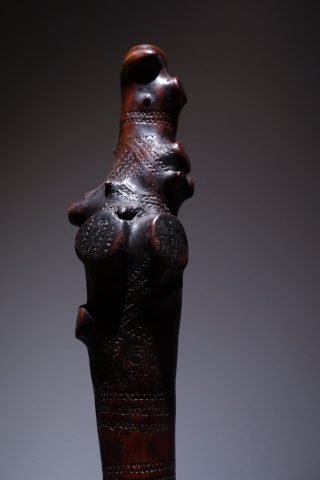Classic African and Oceanic Art steadily growing at Sotheby’s
Sotheby’s African and Oceanic Art auction in Paris goes above €10 million and proves that the market is rapidly recovering from unsatisfying 2016.
- Pair of ‘Rapa’, Easter Island, Polynesia.
- Maori Pendant, Hei Tiki, New Zeland.
- Lumbu figure, Gabon.
- Vunikau Club, Fiji Islands, Polynesia.
- Kota Helmet-Mask, Gabon.
- We / Guere Mask, (Ivory Coast.
Last night at Sotheby’s Paris Oceanic and African art market paid a tribute to art history with a successful auction including 66 selected pieces from the most interesting areas of the Continent and Indian Ocean. You may say that fetching ‘only’ €10.725.500 and leaving roughly 20 unsold pieces on the ground is nothing to be happy about these days; but we would not agree with that. Classic African art market is very hot at the moment, as it was clear during the last edition of Parcours du Monde, in Paris. It’s probably too hot, and this auction was a success because it proved that the market is still very selective. African and Oceanic art is steadily growing, instead of bubbling. Before yesterday Sotheby’s ‘Arts d’Afrique et d’Océanie‘ auction reached €10 million only in a single occasion. It was June 2015, when the art market was peaking (auction total €11.101.775). Last June it scored only €4.338.750, while in December 2016 the total sale was €2.632.125.
Last night the sale’s highlights had strong market. The outstanding pair of ‘Rapa’ form Easter Island, in Polynesia, doubled the estimate and went sold for €3.876.700 (buyer’s premium included). The Rapa were dancing tools, “usually held in each hand, but from time to time [during the dance], one and sometimes both are discarded” (Thomson, “Te Pito te Henua, or Easter Island”, Annual Report of the Board of Regents of the Smithsonian Institution, 1891, p. 491 – quote from auction’s catalogue). Their minimal decoration, likely reminding Europeans of the typical medieval archways in architecture, jewellery, altar pieces or decorated book, is dramatically expressive. Similarly, a powerful Maori Pendant from Hei Tiki, New Zeland, fetched €27.500; the auction house estimated to sell it between €12.000 and 18.000. The piece had a solid provenance and was of an extraordinary quality, proving that it belonged to a mighty family. It is not for a case that Sotheby’s chose it as the first item to be auctioned and put it on exhibition beside the above mentioned pair of Rapa.
Also the indigo and red Lumbu figure from Gabon almost doubled the high estimate. It sold for €175,000. ‘The Lumbu call chimpanzees nzighu – wrote art historian Charlotte Grand-Dufay in the auction catalogue –, and their sculptural interpretation reveals the unique ingenuity of the art of the Lumbu people and the cultural specificity of their style’. But that ingenuity didn’t prevent them from employing a reflecting material for the statue eyes and turning the chimpanzee into an iconic two legs entity that could easily find a place in a Bosch painting.
Oceanic clubs’ lovers may have noticed that the Vunikau Club from the Fiji Islands (Polynesia) went sold for €13,750 (estimate €6,000 – 9,000), while the Kota Helmet-Mask (Gabon) sold at €31,250, in the area of its low estimate. It was bought by writer and adventurer Daniel Henriot in Batouala exactly 50 years ago.
Among the pieces that last night didn’t find a buyer we would like to mention the We / Guere Mask, (Ivory Coast). Estimated to sell between €20.000 and 30.000 the piece was expressive and well preserved, but it couldn’t count on a provenance as strong as the above mentioned pieces, and probably that was the main problem. Despite expectations about African economy and African art market are high at the moment, and a generation of new collectors is emerging, also in this area the market is getting very selective and polarized. But this is a very good news indeed.
December 14, 2017






